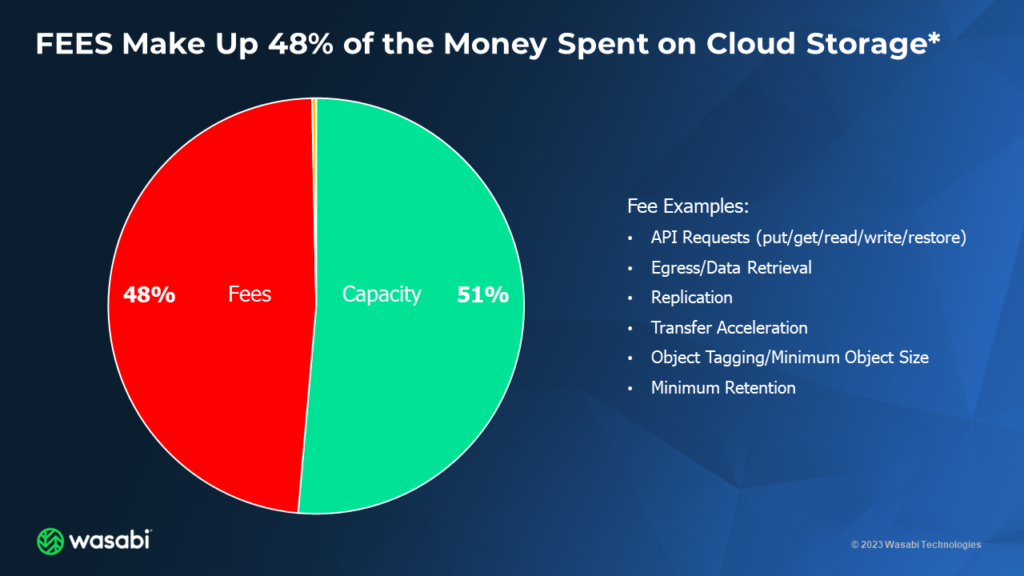BUSINESS
37Signals Left the Cloud. But Did They Have To Leave Cloud Storage?
37Signals Left the Cloud. But Did They Have To Leave Cloud Storage?
Last October, when economic turmoil dominated the headlines, technology pundits rushed to their blogs and podcasts to share their predictions about the cloud. Some declared the cloud era was over and the pendulum was swinging back to on-premises computing. Others proclaimed that the cloud’s flexibility and ease-of-use would prevail in the new disaggregated workplace. Still others couldn’t pick a side and stuck with their “hybrid cloud is the way” story.
One of the loudest, most impactful voices was that of David Heinemeier Hansson (DHH) of 37Signals, the company behind Basecamp, the ubiquitous project management SaaS, and HEY, their cloud-based email management software. In his October 19, 2022 blog post titled “Why we’re leaving the cloud,” DHH wrote about unrealized benefits promised by Big Cloud (my words) as the primary factor behind their decision to repatriate their applications.
Renting computers is (mostly) a bad deal for medium-sized companies like ours with stable growth. The savings promised in reduced complexity never materialized.”
DHH justifies his position nicely, noting that there are other, perhaps more sinister and dangerous issues at play with the hyperscalers.
But this isn't just about cost. It's also about what kind of internet we want to operate in the future. It strikes me as downright tragic that this decentralized wonder of the world is now largely operating on computers owned by a handful of mega-corporations. If one of the primary AWS regions go down, seemingly half the internet is offline along with it.”
To this point about the dominance of the “mega-corporations,” I couldn’t agree with him more. As a start-up, Wasabi has always pointed out that storing data exclusively with one of the big players is a potentially losing proposition–the proverbial “putting all your eggs in one basket” conundrum. So what does any of this have to do with cloud storage? Well, as a follow-up to the initial declaration, DHH and company have published additional articles explaining their justification for leaving the cloud. As part of that dialog, they offer some insights into their compute billing as well as their storage costs.
And finally, S3, where we are storing around 8 petabytes of files, we spent a whopping $907,838 ($75,653/month) in 2022. It’s worth noting that this setup uses a dual-region replication strategy, so we’re resilient against an entire AWS region disappearing, including all the availability zones. To serve those files, and other static assets, we spent $66,742 ($5,562/month) in 2022 on CloudFront CDN services.”
Without any deep insight into the activity level of that data (the volume of writes/reads/lists/etc.) it appears they paid ~$9.46/TB/month, a significant discount from the list price of $23.00/TB/month for AWS S3 Standard. (The simple math: 8 PB = 8,000 TB; $908K annual costs/8,000 TB/12 months = $9.458/TB/month.) Now, is that all in, meaning all transaction fees included? They didn’t say.
I bring up that question because our recently released Wasabi Cloud Storage Index revealed that customers using cloud storage services from hyperscalers typically pay 48% of their total bill just for fees, with 51% going toward the actual capacity used.

If I were the cynical type, I’d say that the $908K paid in 2022 was just 51% of the total cost for storage and there was another $872K in fees, bringing the total cost up to $1.71M. Whatever the true cost really was, once they withdraw most or all of their computing workloads, there is a reasonable expectation that any discounts they receive for that storage will evaporate and the cost to store those 8 petabytes of data will go up, significantly. [Editor’s note: in a recent podcast, DHH discussed their “private pricing” enterprise agreements, and Jeff Bezos’ ownership stake, all combined to optimize their cloud spending.]
Why should you care? Why should 37Signals care?
If you are storing your object data with a hyperscaler, I have no doubt that you are paying far more than anticipated, particularly in the fees associated with accessing your data, which is relevant to how you leverage the value of your data. If you use Wasabi Hot Cloud Storage for your business, you can expect to pay only for the capacity you use, with no additional fees. That means that with Wasabi, you can store 4-5x more data at the same cost you’re paying today without any surprises along the way.
There is a power in having a predictable, linear cost for any service you employ. I’d bet if the server-by-the-hour business was as predictable as Wasabi’s cloud storage cost structure, there wouldn’t be a sudden migration back to on-premises computing.
While the server and software vendors are stacking up outside the virtual doors to 37Signals, waiting to cash in on the opportunity to secure a 3-year deal for new servers and infrastructure software, I would encourage DHH and company to take a good look at their cloud storage bill to see where the money is really going.
The cloud isn’t all that bad, especially when the pricing aligns with your workloads and your business model. Besides, we have a 30-day free trial if you want to see for yourself what a great deal Wasabi is for any service provider, big or small!

2023 Wasabi Cloud Index: Executive Summary Report
Find out what your peers are thinking about their cloud storage strategy and the challenges they face.
Download Report

the bucket
Last October, when economic turmoil dominated the headlines, technology pundits rushed to their blogs and podcasts to share their predictions about the cloud. Some declared the cloud era was over and the pendulum was swinging back to on-premises computing. Others proclaimed that the cloud’s flexibility and ease-of-use would prevail in the new disaggregated workplace. Still others couldn’t pick a side and stuck with their “hybrid cloud is the way” story.
One of the loudest, most impactful voices was that of David Heinemeier Hansson (DHH) of 37Signals, the company behind Basecamp, the ubiquitous project management SaaS, and HEY, their cloud-based email management software. In his October 19, 2022 blog post titled “Why we’re leaving the cloud,” DHH wrote about unrealized benefits promised by Big Cloud (my words) as the primary factor behind their decision to repatriate their applications.
Renting computers is (mostly) a bad deal for medium-sized companies like ours with stable growth. The savings promised in reduced complexity never materialized.”
DHH justifies his position nicely, noting that there are other, perhaps more sinister and dangerous issues at play with the hyperscalers.
But this isn't just about cost. It's also about what kind of internet we want to operate in the future. It strikes me as downright tragic that this decentralized wonder of the world is now largely operating on computers owned by a handful of mega-corporations. If one of the primary AWS regions go down, seemingly half the internet is offline along with it.”
To this point about the dominance of the “mega-corporations,” I couldn’t agree with him more. As a start-up, Wasabi has always pointed out that storing data exclusively with one of the big players is a potentially losing proposition–the proverbial “putting all your eggs in one basket” conundrum. So what does any of this have to do with cloud storage? Well, as a follow-up to the initial declaration, DHH and company have published additional articles explaining their justification for leaving the cloud. As part of that dialog, they offer some insights into their compute billing as well as their storage costs.
And finally, S3, where we are storing around 8 petabytes of files, we spent a whopping $907,838 ($75,653/month) in 2022. It’s worth noting that this setup uses a dual-region replication strategy, so we’re resilient against an entire AWS region disappearing, including all the availability zones. To serve those files, and other static assets, we spent $66,742 ($5,562/month) in 2022 on CloudFront CDN services.”
Without any deep insight into the activity level of that data (the volume of writes/reads/lists/etc.) it appears they paid ~$9.46/TB/month, a significant discount from the list price of $23.00/TB/month for AWS S3 Standard. (The simple math: 8 PB = 8,000 TB; $908K annual costs/8,000 TB/12 months = $9.458/TB/month.) Now, is that all in, meaning all transaction fees included? They didn’t say.
I bring up that question because our recently released Wasabi Cloud Storage Index revealed that customers using cloud storage services from hyperscalers typically pay 48% of their total bill just for fees, with 51% going toward the actual capacity used.

If I were the cynical type, I’d say that the $908K paid in 2022 was just 51% of the total cost for storage and there was another $872K in fees, bringing the total cost up to $1.71M. Whatever the true cost really was, once they withdraw most or all of their computing workloads, there is a reasonable expectation that any discounts they receive for that storage will evaporate and the cost to store those 8 petabytes of data will go up, significantly. [Editor’s note: in a recent podcast, DHH discussed their “private pricing” enterprise agreements, and Jeff Bezos’ ownership stake, all combined to optimize their cloud spending.]
Why should you care? Why should 37Signals care?
If you are storing your object data with a hyperscaler, I have no doubt that you are paying far more than anticipated, particularly in the fees associated with accessing your data, which is relevant to how you leverage the value of your data. If you use Wasabi Hot Cloud Storage for your business, you can expect to pay only for the capacity you use, with no additional fees. That means that with Wasabi, you can store 4-5x more data at the same cost you’re paying today without any surprises along the way.
There is a power in having a predictable, linear cost for any service you employ. I’d bet if the server-by-the-hour business was as predictable as Wasabi’s cloud storage cost structure, there wouldn’t be a sudden migration back to on-premises computing.
While the server and software vendors are stacking up outside the virtual doors to 37Signals, waiting to cash in on the opportunity to secure a 3-year deal for new servers and infrastructure software, I would encourage DHH and company to take a good look at their cloud storage bill to see where the money is really going.
The cloud isn’t all that bad, especially when the pricing aligns with your workloads and your business model. Besides, we have a 30-day free trial if you want to see for yourself what a great deal Wasabi is for any service provider, big or small!

2023 Wasabi Cloud Index: Executive Summary Report
Find out what your peers are thinking about their cloud storage strategy and the challenges they face.
Download Report
featured articles
WASABI MEDIA & ENTERTAINMENT
April 10, 2024
Introducing Wasabi AiR: Unleash the Power of AI wit...
Introducing Wasabi AiR: Unleash the Power of AI wi...
TECHNOLOGY
April 23, 2024
Responsible AI Use: Lessons from an Industry Inside...
Responsible AI Use: Lessons from an Industry Insid...
TECH PARTNERS HEALTHCARE
April 18, 2024
Protect Your Research Data with Cost-friendly, Powe...
Protect Your Research Data with Cost-friendly, Pow...
TECH PARTNERS
April 11, 2024
Addressing AI Infrastructure Challenges with Wasabi...
Addressing AI Infrastructure Challenges with Wasab...
VIDEO SURVEILLANCE
April 9, 2024





